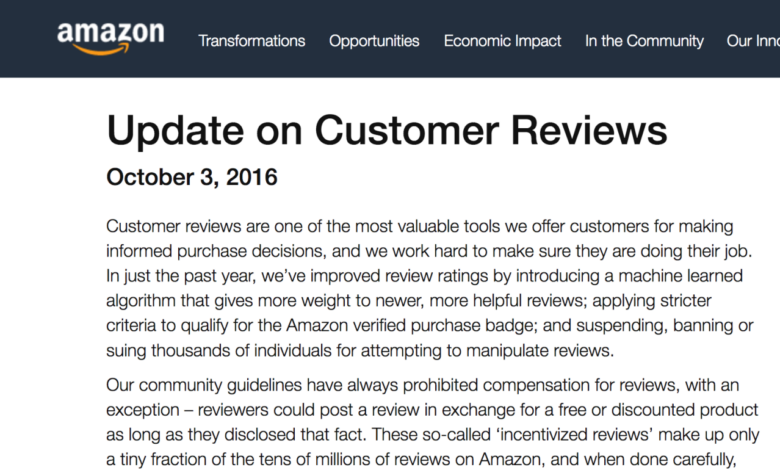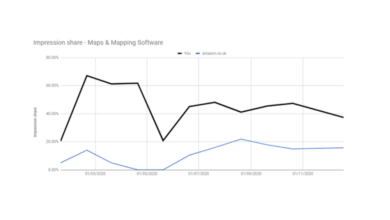
Amazon Review Guidelines A Comprehensive Guide
Amazon review guidelines are crucial for maintaining a trustworthy marketplace. This comprehensive guide delves into the intricacies of these guidelines, offering insights into various aspects, from understanding the core principles to navigating the complexities of different product categories and seller responsibilities. We’ll explore how customer behavior, moderation processes, legal considerations, and best practices for writing compliant reviews all contribute to a positive Amazon experience.
Understanding Amazon’s review guidelines is essential for both buyers and sellers. By adhering to these guidelines, everyone can contribute to a fair and transparent marketplace, ensuring that reviews accurately reflect product quality and user experiences. This guide will dissect the nuanced aspects of these guidelines, allowing readers to confidently navigate the Amazon review ecosystem.
Understanding Amazon Review Guidelines
Navigating the online marketplace requires a clear understanding of the rules governing user-generated content. Amazon’s review guidelines are crucial for maintaining a trustworthy and fair environment for both buyers and sellers. These guidelines, while seemingly straightforward, encompass a range of nuances that impact how reviews are perceived and utilized.Amazon’s review guidelines aim to promote authenticity and helpfulness in product reviews.
They are designed to prevent fraudulent, misleading, or inappropriate content from affecting customer decisions and potentially harming businesses. By adhering to these guidelines, both reviewers and sellers can contribute to a more transparent and beneficial online shopping experience.
Key Principles of Amazon Review Guidelines
Amazon prioritizes reviews that are genuine, helpful, and relevant to the product being reviewed. This includes focusing on factual descriptions, avoiding exaggerated claims, and maintaining a respectful tone. These principles are the foundation for building trust and credibility on the platform. A review’s value hinges on its truthfulness and usefulness to other potential customers.
Prohibited Review Types
Reviews that violate Amazon’s guidelines are removed or flagged. This includes various types of inappropriate content, which can be broadly categorized into those that are misleading, those that are offensive, and those that are irrelevant. A clear understanding of these prohibited categories is essential for responsible review writing.
Consequences of Violating Guidelines
Violating Amazon’s review guidelines can lead to penalties ranging from account suspension to review removal. These consequences can have significant repercussions for both individual reviewers and businesses. The seriousness of the violation directly influences the penalty imposed.
Problematic Review Areas
Several areas frequently present challenges in adhering to Amazon’s review guidelines. Reviews often become problematic when they involve exaggeration, manipulation, or personal attacks. These issues can undermine the platform’s credibility and hinder fair product evaluations.
Impact on Customer Trust and Perception
Amazon’s guidelines significantly impact customer trust and perception. When reviews are genuine and helpful, they foster confidence in the platform and the products listed. However, fraudulent or misleading reviews erode this trust, leading to a negative perception of both the product and the platform itself.
Table of Prohibited Review Types
| Prohibited Review Type | Reason for Prohibition | Examples |
|---|---|---|
| Exaggerated Claims | Reviews that inflate product capabilities or benefits beyond reality. | “This phone is the best ever!” (without specific supporting details), “This product fixed all my problems!” |
| Misleading Descriptions | Reviews that misrepresent the product’s features, functionality, or condition. | Reviewing a used product as new, falsely claiming a product’s ability to do something it can’t. |
| Offensive Language | Reviews containing insults, hate speech, or personal attacks. | Using derogatory terms, targeting specific groups, or making offensive comments about the seller or other customers. |
| Irrelevant Content | Reviews that do not relate to the product being reviewed. | Reviewing a phone but focusing on unrelated topics, like the restaurant near the store. |
| Promotional Content | Reviews that promote other products or services. | Reviews that are disguised advertisements for unrelated products, or reviews that are designed to boost the product’s popularity instead of providing an honest assessment. |
Review Guidelines for Different Product Categories: Amazon Review Guidelines
Navigating the world of online reviews can be tricky, especially when dealing with diverse product categories. Amazon, in its effort to maintain a trustworthy and helpful review ecosystem, establishes specific guidelines for each product type. Understanding these distinctions is crucial for both reviewers and consumers, ensuring reviews are relevant and helpful. This section delves into the varying review guidelines across product categories, highlighting commonalities and differences, and acknowledging potential challenges.Review guidelines aren’t one-size-fits-all; they’re tailored to the unique characteristics of each product category.
This is important because a review of a high-tech device requires a different approach compared to a review of a novel. These nuanced guidelines aim to provide consumers with valuable insights that can facilitate informed purchasing decisions.
Electronics Reviews
Amazon’s guidelines for electronics reviews emphasize technical accuracy and practical usability. Reviewers are encouraged to provide detailed descriptions of product features, performance benchmarks, and comparisons with similar models. This ensures that reviews aren’t just subjective opinions but offer concrete information to help potential buyers make well-informed decisions. For example, a review of a smartphone should include specific details about camera quality, processing speed, battery life, and ease of use.
Reviews focused solely on aesthetic appeal without quantifiable data may not be as helpful to the target audience.
Fashion Reviews
Fashion reviews often prioritize the fit, quality, and style of garments. Reviewers are encouraged to describe the material, construction, and overall appearance of the clothing. Pictures are frequently encouraged to showcase the garment’s visual appeal in different settings and from various angles. Reviews for clothing items often need to address size accuracy and how the garment looks on different body types, which can be a challenging aspect to convey.
Book Reviews
Book reviews focus on the content, plot, characters, and overall narrative. Reviewers are encouraged to summarize the book’s key themes and discuss its literary merit. In the context of book reviews, specific examples of relevant plot points or character development can strengthen the review. However, revealing major plot spoilers should be avoided, as it can affect the reading experience for others.
Comparison of Guidelines Across Categories
| Product Category | Specific Guideline Examples | Potential Issues |
|---|---|---|
| Electronics | Accuracy of specifications, performance benchmarks, comparison with similar products | Subjectivity, lack of quantifiable data, focus on aesthetics over functionality |
| Fashion | Fit, quality, style, material description, accurate size information | Difficulty in conveying fit accurately, reliance on visual aids, potential for bias based on personal preference |
| Books | Summary of plot, character analysis, literary merit, avoiding spoilers | Subjectivity in literary merit, potential for bias based on personal preferences |
Challenges in Applying Uniform Guidelines
Implementing uniform guidelines across all product categories presents challenges. Different product types require different kinds of expertise and specific details. For example, a review of a complex piece of electronics necessitates technical knowledge, while a review of a piece of clothing requires a fashion sense. There is a potential for inconsistencies in how the guidelines are applied, which may affect the reliability and helpfulness of reviews.
A uniform approach, while desirable, can sometimes struggle to address the intricacies of each category.
Review Guidelines and Seller Responsibilities
Navigating Amazon’s review system can feel like navigating a maze, but understanding the guidelines and your responsibilities as a seller is crucial for success. Amazon’s rigorous review policies are designed to ensure a fair and transparent marketplace for both buyers and sellers. A strong understanding of these guidelines, and a proactive approach to managing reviews, can significantly impact your product’s visibility and sales.Amazon’s review system, while designed to protect customers, also imposes specific responsibilities on sellers.
These responsibilities are not just about avoiding negative reviews; they are about building trust and fostering a positive buyer experience. Sellers need to be aware that their actions directly influence the perception of their products and brand, and that upholding the guidelines is essential for long-term success on the platform.
Seller Impact on Product Perception, Amazon review guidelines
Amazon’s review guidelines have a direct impact on how buyers perceive your products. Positive reviews build trust, enhance credibility, and encourage purchases. Conversely, negative reviews, if not handled appropriately, can deter potential customers. The tone and content of reviews can influence sales and even affect product rankings.
Seller’s Role in Maintaining Positive Review Standards
Sellers play a vital role in maintaining a high standard of reviews. This goes beyond simply avoiding negative reviews. It encompasses proactive steps to encourage genuine customer feedback and address any issues that may arise. Honest communication, transparency, and a commitment to customer satisfaction are essential elements in maintaining a positive reputation. This involves acknowledging and responding to both positive and negative feedback.
Strategies for Managing and Responding to Reviews
Effective review management requires a multifaceted approach. A key strategy involves proactive measures to encourage positive reviews. This includes prompt shipping, excellent communication, and a commitment to resolving customer issues quickly and efficiently. When a negative review arises, a prompt and professional response is crucial. Acknowledge the customer’s concern, apologize for any inconvenience, and offer a solution.
Amazon review guidelines are crucial for product visibility, but did you know how these reviews affect your SEO results ? Positive reviews, when well-written and following guidelines, can significantly boost your product’s ranking on search engine results pages. Ultimately, adhering to Amazon’s review policies is key for a successful product listing.
Importance of Proactive Measures for Compliance
Proactive measures for compliance are not just good practice; they are essential for long-term success on Amazon. By consistently adhering to the guidelines, sellers demonstrate their commitment to fair trade practices and build trust with buyers. Regular review of Amazon’s guidelines and seller policies, and a commitment to continuous improvement, are crucial for staying compliant.
Table of Seller Responsibilities
| Seller Responsibilities | Potential Issues | Recommended Actions |
|---|---|---|
| Providing accurate product descriptions and high-quality images. | Inaccurate or misleading descriptions, low-quality images. | Ensure descriptions are detailed and accurate, using high-quality images that reflect the product. |
| Responding promptly and professionally to customer feedback, both positive and negative. | Ignoring customer feedback, responding inappropriately. | Establish a system for promptly responding to reviews, providing solutions to issues, and thanking customers for positive feedback. |
| Ensuring products meet Amazon’s quality standards. | Defective products, inconsistent product quality. | Implementing rigorous quality control measures, offering refunds or replacements for defective items. |
| Following Amazon’s policies on reviews and refunds. | Misrepresenting or manipulating reviews. | Strictly adhering to Amazon’s review and refund policies, refraining from any form of manipulation. |
Review Guidelines and Customer Behavior

Understanding customer behavior is crucial for effectively applying Amazon review guidelines. Customers, driven by various motivations and biases, may submit reviews that are not entirely representative of their experience. This section delves into how customer behavior impacts the validity and interpretation of reviews, offering insights into recognizing manipulative or deceptive practices.Customer behavior significantly influences how review guidelines are applied.
Factors like personal experiences, emotional responses, and even external pressures can shape the content and tone of a review. Understanding these influencing factors is essential for distinguishing genuine feedback from potentially misleading information.
Customer Motivations and Biases
Customer reviews are often influenced by a complex interplay of motivations. Some customers may be genuinely sharing their experience, while others may be driven by a desire for attention, a need to express dissatisfaction, or a hidden agenda. These motivations can introduce bias into the review process. Common motivations include the desire for free products or compensation, a need to vent negative emotions, or a desire to promote a competitor’s product.
Product-specific motivations, like the need to provide a solution for a common problem, also exist.
Following Amazon review guidelines is crucial for product success. It’s all about honesty and helpfulness, avoiding promotional language. This week’s Ignite Marketer, Lara Hood Balazs, CMO & GM at Intuit, a brilliant example of effective marketing strategies , highlights the importance of genuine customer feedback. Ultimately, adhering to these guidelines builds trust and positive reviews, vital for any online seller.
Impact of Reviews on Customer Decision-Making
Customer reviews significantly impact purchasing decisions. Positive reviews can build trust and encourage purchases, while negative reviews can deter potential buyers. Reviews, whether genuine or fabricated, can sway a customer’s perception of a product or service. The perceived trustworthiness of a review greatly influences a customer’s decision. A single negative review from a seemingly reliable source can significantly reduce customer confidence.
Conversely, multiple positive reviews from independent sources can increase a buyer’s likelihood of purchasing.
Identifying Manipulative or Deceptive Review Practices
Recognizing manipulative or deceptive review practices requires careful analysis of review content. Look for reviews that are overly positive or negative, lacking specific details, or exhibiting unusual patterns. Reviews that are excessively complimentary without mentioning specific features, or those that solely focus on negative aspects without context, should raise suspicion. Inconsistencies in review language or timing also suggest possible manipulation.
For example, a sudden surge in negative reviews shortly after a competitor launched a similar product could indicate coordinated efforts.
Amazon review guidelines are crucial for maintaining a positive shopping experience. Understanding how these guidelines impact search engine results pages (SERP) is key, especially when considering the influence of SERP features like rich snippets and product placement. Ultimately, following the guidelines ensures that genuine customer feedback remains visible and helpful for potential buyers, ultimately boosting your Amazon presence.
Misinterpretation and Misuse of Customer Reviews
Customer reviews can be misinterpreted or misused in various ways. A single negative review, without context, can be easily misconstrued. Also, reviews that are highly emotional or subjective may not accurately reflect the overall experience. Furthermore, a lack of specific details in a review can lead to inaccurate conclusions about a product or service.
Examples of Misinterpreted or Misused Reviews
| Review Type | Potential Bias | Impact on Customer Decision-Making |
|---|---|---|
| Excessively positive review of a product with no specific details. | Potential for a paid or incentivized review. | Customer may be misled into purchasing a product without a true understanding of its quality. |
| Negative review citing minor issues without context. | Potential for a dissatisfied customer focusing on insignificant aspects. | Customer may avoid purchasing the product based on a single, possibly exaggerated complaint. |
| Review expressing strong emotional dissatisfaction without context. | Potential for a review with exaggerated negative sentiment. | Customer may be discouraged from purchasing the product based on an overly emotional review. |
| Review focusing only on the negative aspects of a product. | Potential for a competitor’s review or a customer seeking compensation. | Customer may avoid purchasing the product based on a one-sided view. |
Review Guidelines and Moderation Processes
Amazon’s commitment to maintaining a trustworthy and helpful review ecosystem is paramount. To achieve this, a robust review moderation process is essential. This process safeguards the integrity of customer feedback, ensuring a fair and transparent platform for both buyers and sellers.The system is designed to identify and address potentially inappropriate or misleading reviews, while allowing genuine, helpful feedback to flourish.
This careful balance is crucial for the continued success of Amazon’s marketplace.
Amazon’s Review Moderation Processes
Amazon employs a multi-faceted approach to review moderation, combining human expertise with advanced AI technology. This hybrid approach aims to detect and handle a wide range of potential issues in a timely and efficient manner.
Role of Human Moderators
Human moderators play a vital role in the process. They possess the crucial ability to interpret context and nuances that AI algorithms might miss. This human element is especially important for evaluating reviews that are potentially offensive, misleading, or violate Amazon’s review guidelines. For example, a human moderator can differentiate between a genuine complaint about a product defect and a fabricated review aimed at harming a seller’s reputation.
Role of AI in Review Moderation
AI algorithms are increasingly used to screen reviews for automated flagging. These algorithms analyze vast amounts of data, identifying patterns and anomalies that might indicate violations of review guidelines. This includes detecting instances of spam, inflated praise, or reviews that are too vague or too subjective. For instance, AI can flag reviews that contain repetitive phrases or s often associated with fake reviews.
Review Moderation Scenarios
Various scenarios necessitate review moderation. A review claiming a product caused serious health issues would require careful scrutiny. Similarly, reviews with extreme language or threats against other customers or sellers need immediate action. Another example involves reviews that are clearly promotional in nature, masquerading as genuine customer feedback.
Limitations of Automated Review Moderation Systems
While AI is invaluable in accelerating the process, automated systems have inherent limitations. They often struggle with subtle nuances in language, sarcasm, or irony. Contextual understanding, which is a core strength of human moderators, is frequently lacking in automated systems. For example, a review expressing dissatisfaction with a product’s design might be misinterpreted by an AI as negative sentiment, while the customer is actually highlighting an unusual feature.
Stages of Review Moderation
| Stage | Description |
|---|---|
| Initial Review Submission | Customers submit reviews for products they have purchased. |
| Moderation | Amazon’s review moderation system processes the reviews. This involves initial filtering using AI and subsequent human review of flagged reviews. |
| Final Approval or Rejection | Based on the moderation process, reviews are either approved for public display or rejected. Rejected reviews are often explained to the customer, giving them the opportunity to revise. |
Review Guidelines and Legal Considerations
Navigating the online review world, especially on a platform as large as Amazon, requires a keen awareness of the legal ramifications. Reviews, while intended to help consumers make informed choices, can inadvertently become a breeding ground for legal disputes. This section delves into the legal landscape surrounding Amazon reviews, examining the potential pitfalls and how to navigate them effectively.Amazon’s review guidelines, while aiming to foster trust and transparency, also have legal implications.
These guidelines, when not followed, can lead to repercussions for both reviewers and sellers. Understanding these legal implications is crucial for everyone participating in the Amazon review system.
Legal Implications of Amazon Review Guidelines
Amazon’s review guidelines, although not legally binding contracts, are implicitly recognized as part of the platform’s terms of service. Breaching these guidelines can lead to consequences ranging from review removal to account suspension. These actions, while often initiated by Amazon’s automated systems, can still have legal implications, particularly if the review is perceived as defamatory or misleading. In cases of dispute, legal precedents may be invoked to support or challenge Amazon’s actions.
Relevant Laws and Regulations
Various laws and regulations govern online reviews, especially those related to consumer protection, defamation, and intellectual property. Laws pertaining to false advertising, misleading statements, and unfair competition can apply to online reviews that contain inaccurate or misleading information. Consumer protection laws often safeguard consumers from deceptive reviews, while intellectual property laws can protect trademarks and copyrights.
Potential Legal Challenges Related to Reviews
Several potential legal challenges can arise from Amazon reviews. One common issue is the spread of false or misleading reviews, which can damage a seller’s reputation and potentially lead to financial losses. Defamatory statements made in reviews, even if anonymously posted, could lead to legal action. Copyright infringement, if a review utilizes copyrighted material without permission, could also be a source of legal trouble.
Handling Reviews Raising Legal Concerns
When a review raises legal concerns, a cautious and methodical approach is crucial. If a review is deemed defamatory or violates intellectual property rights, documenting the evidence is critical. Consulting with legal counsel familiar with online review laws is highly recommended to determine the best course of action. Amazon’s own dispute resolution mechanisms should also be explored before resorting to external legal proceedings.
Detailed Explanation of Legal Aspects
The legal aspects of Amazon reviews are complex and depend on numerous factors. For instance, a review claiming a product is defective and causing harm could potentially trigger product liability claims. A review that misrepresents a competitor’s product or disparages their business might involve claims of unfair competition. Furthermore, a review that contains copyrighted material without permission could lead to a copyright infringement claim.
Consider a review stating a product is “dangerous” without substantiation. This could be grounds for legal action if the seller can prove that the review is false or misleading.
Specific Examples and Illustrations
Imagine a review claiming a particular brand of baby formula causes allergic reactions. If this review can be proven false and has a negative impact on sales, the affected brand might seek legal recourse. Or, a review that includes a competitor’s logo or brand name in a derogatory manner could potentially violate trademark laws. These are just two illustrations of the myriad ways in which online reviews can trigger legal challenges.
Amazon’s review guidelines and policies, while designed to be helpful, need to be understood within the larger legal framework. These examples illustrate the need for caution and awareness when engaging in online reviews.
Best Practices for Following Amazon Review Guidelines
Navigating the world of online reviews can feel like navigating a maze. Amazon, with its vast marketplace, has specific guidelines to ensure a positive and trustworthy experience for all. Understanding these guidelines, and more importantly, how toapply* them, is crucial for both buyers and sellers. This section focuses on practical, actionable advice for crafting reviews that comply with Amazon’s policies, helping you avoid common pitfalls and contribute meaningfully to the community.Following Amazon’s review guidelines is essential for maintaining a positive user experience and avoiding account suspension.
The guidelines are designed to ensure that reviews are helpful, honest, and informative. By adhering to these best practices, you contribute to a marketplace where consumers can make informed decisions.
Writing Compliant Reviews
Amazon’s review guidelines emphasize honesty and helpfulness. Reviews should focus on the product itself, providing specific details and avoiding personal attacks or irrelevant commentary. A key aspect is providing factual information about your experience, which can help other customers make a purchasing decision.
- Focus on the product, not the seller. Describe the product’s features, performance, and overall value. Avoid personal attacks, complaints about customer service, or irrelevant topics.
- Be specific and detailed. Instead of simply stating “good,” describe what aspects of the product were good. Use quantifiable details whenever possible. For example, instead of “fast delivery,” say “arrived two days earlier than expected.” This enhances the review’s usefulness.
- Maintain objectivity. Present your experience honestly and fairly. Avoid exaggerated claims or opinions that aren’t supported by your experience. For example, don’t write “the best product ever” if your experience was simply satisfactory. Stick to the facts.
- Be accurate and truthful. Ensure all statements made in your review are factual and based on your own experience. Don’t make claims you can’t back up or spread misinformation. This protects both you and other users.
- Avoid inappropriate language or content. Amazon’s guidelines explicitly prohibit hate speech, harassment, and any content that could be considered offensive. Maintain a professional and respectful tone throughout your review.
Avoiding Common Pitfalls
Review guidelines are designed to prevent manipulation and dishonest reviews. Unintentional mistakes can still lead to your review being flagged or removed. Knowing the common pitfalls is crucial to avoiding problems.
- Exaggerated claims. Avoid overstating the product’s benefits or features. For instance, claiming a product can perform miracles or solve problems it doesn’t address directly is a common error. Instead, focus on accurate and detailed descriptions of your experience.
- Reviewing products you haven’t purchased. Amazon prohibits reviews from users who haven’t actually used the product. This is to ensure reviews are authentic and reflect genuine experiences. This is a common and serious violation.
- Personal attacks or seller criticism. Reviews should be focused on the product, not the seller. Complaints about customer service or seller policies should be directed elsewhere. Personal opinions about the seller or their business practices have no place in a product review.
- Promoting other products. Amazon prohibits reviews from promoting other products or services. Keep your focus on the product you are reviewing. This is important for the integrity of the platform.
- Using the review to promote a specific opinion or cause. Avoid using the review to advocate for a political or social cause. Reviews should be focused on the product’s performance and value.
Final Summary

In conclusion, Amazon review guidelines are multifaceted, encompassing various factors impacting customer trust and seller responsibilities. Navigating these guidelines requires a deep understanding of the principles, different product categories, and the role of customer behavior. By recognizing the potential biases, understanding the moderation processes, and adhering to best practices, both buyers and sellers can contribute to a more reliable and informative Amazon marketplace.
This guide serves as a starting point for comprehending and adhering to these crucial guidelines.





